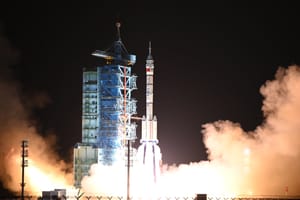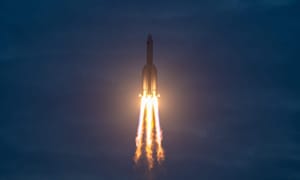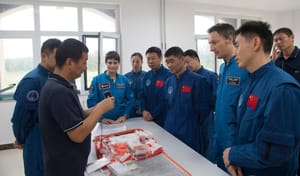
Oct 30, 2024
China launches Shenzhou-19 taikonauts to its space station
China launched its eighth crewed mission to its Tiangong Space Station at 04:27 am China Standard Time (October 29th), or 20:47 pm Universal Coordinated Time (October 30th). This new crew will take over from the outgoing Shenzhou-18 crew, after sharing the station with them for a few days.
The #LongMarch2F Y19 rocket, carrying #Shenzhou19 manned spaceship, blasted off at 4:27am BJT on Oct 30, from #Jiuquan Satellite Launch Center in northwest China.
— Wu Lei (@wulei2020) October 29, 2024
About 10 minutes after the launch, the spaceship separated from the rocket and entered its designated orbit. 🎉🎉🎉 pic.twitter.com/A3JVcNpTct
The Shenzhou-19 mission lifting off atop of a Long March 2F/G from the Jiuquan Satellite Launch Center, via Wu Lei on X.
The mission launched from Launch Area 4 of the Jiuquan Satellite Launch Center, located in the north of China, atop of a Long March 2F/G rocket. According to the China Manned Space Agency, the Shenzhou-19 launch mission was a complete success with plans to 'fast rendevous' with the Tiangong Space Station beginning shortly after. This rendevous brought the spacecraft close to the space station within six hours.
After completing its 'fast rendevous', docking is reported to have occurred at 11:00 am China Standard Time, or 03:00 am Universal Coordinated Time, at the Tianhe modules forward docking port. Launch to docking took a little over six hours. Leak checks took a few hours before the new crew entered the Tianhe core module.

With the Shenzhou-19 crew adjusting to the microgravity environment aboard the space station, the Shenzhou-18 crew will begin preparing for their journey back to Earth. Return of the Shenzhou-18 crew is currently expected no earlier than November 4th.
Meet the Shenzhou-19 crew
Cai Xuzhe

The commander of the Shenzhou-19 mission is Cai Xuzhe (蔡旭哲), making his second trip to the space station. Cai Xuzhe's first flight was for the sixth-month Shenzhou-14 mission, lasting from June to December of 2022, this mission saw the Wentian and Mengtian modules dock as well as having the first crew handover, when the Shenzhou-15 crew arrived.
Cai is from Shenzhou, in Hebei province, and has served in the People's Liberation Army Air Force. In 2010 he was selected as part of the second group of taikonauts. After the Shenzhou-14 mission, Cai was awarded the honorary title of "Heroic Astronaut" in March 2023.
Wang Haoze

The science operator for the Shenzhou-19 mission is Wang Haoze (王浩泽), making her first trip to space. Wang Haoze is part of the third group of Taikonauts and was selected in 2020.
Wang is from Chengde, in Hebei province, and was previously a senior engineer at the Academy of Aerospace Propulsion Technology under the China Aerospace Science and Technology Corporation. During her time working as a propulsion engineer, she notably co-authored a paper about nuclear thermal rocket engines.
Song Lingdong

The operator for the Shenzhou-19 mission is Song Lingdong (宋令东), making his first trip to space. Like his crewmate, Song Lingdong is part of the third group of Taikonauts and was selected in 2020.
Song is from Caoxian county, in Shandong Province, and has served in the People's Liberation Army Air Force. Having joined the PLAAF in 2008, Song went on to earn the rank of Lieutenant Colonel along with flying Sukhoi Su-27 and Su-35 aircraft for international joint exercises.
What will the crew do during their stay?
Throughout their stay aboard the Tiangong Space Station, the Shenzhou-19 crew will complete and assist with various experiments running in the orbiting laboratory. Some of these experiments are in the fields of microgravity fundamental physics, space material science, space life science, new space technologies, and space medicine.
The crew will also conduct extravehicular activities, also called spacewalks, to perform maintenance to the space station. In addition to this, the three taikonauts will also participate in public interest and science education activities.
As briefly mentioned already, one of the first activities the crew will perform is taking over from the outgoing Shenzhou-18 crew, once they have adjusted to the microgravity environment. The Shenzhou-18 crew, consisting of Ye Guangfu (叶光富), Li Cong (李聪), and Li Guangsu (李广苏), are set to return to Earth on November 4th, ending a six-month mission that began back in April.
A few weeks into the mission, the crew will oversee the arrival of the Tianzhou-8 cargo spacecraft in mid-November. The cargo spacecraft had been planned to arrive during the Shenzhou-18 mission but was delayed due to Super Typhoon Yagi hitting Hainan province and coming close to the Wenchang launch sites. Tianzhou-8 will be carrying new supplies, consumables, and experiments to the space station.

What is the Shenzhou spacecraft?
The Shenzhou spacecraft is China’s only operational crewed spacecraft and is currently used to ferry its crews to and from the Tiangong space station. The spacecraft has a pressurized volume of almost fifteen cubic meters with a habitable volume of seven cubic meters. Currently, the Shenzhou spacecraft has a crew capacity of three.
Shenzhou consists of a service module, a re-entry module, and an orbital module. The only part of the spacecraft that the crew cannot access is the service module, which also houses the four main engines for performing in-space maneuvers. For generating power, the Shenzhou spacecraft has two solar wings with four panels each that are unfolded after launch, a rotating fixture also attaches them to the service module.

During launch and return to Earth, the crew is seated in the re-entry module. The re-entry module is the only part of the spacecraft that can survive the heat of re-entry and has parachute systems and a landing motor to safely land after return from space. Inside the module, the crew can take control of the spacecraft, access some of the cargo stored during launch and landing, and look out the windows from their seats.
The Shenzhou spacecraft currently launches on the Long March 2F/G rocket from the Jiuquan Satellite Launch Center, at which it has an exclusive launch pad called SLS-1/921. Each Shenzhou spacecraft has a believed launch weight of 8,100 kilograms and an in-space mass of 7,840 kilograms.
Shenzhou refers to both China's crewed space missions and the Shenzhou spacecraft. To date nineteen Shenzhou missions have been launched, with the latest being the fourteenth crewed one.
What is the Long March 2F/G?
The Long March 2F/G is China's only human-rated launch vehicle, with it developed by the China Academy of Launch Vehicle Technology. All flights of the Long March 2F/G have had the boosters, first, and second-stage burn Dinitrogen Tetroxide and Unsymmetrical Dimethylhydrazine.
The payload capacity of the launch vehicle is currently as follows:
- 8,400 kilograms to low Earth orbit

Powering the first-stage are four YF-20B generating a combined 332 tons of thrust burning Dinitrogen Tetroxide and Unsymmetrical Dimethylhydrazine. Augmenting the thrust of the first-stage are four boosters, each powered by one YF-20B each generating 83 tons of thrust each for a combined booster thrust of 332, while also burning Dinitrogen Tetroxide and Unsymmetrical Dimethylhydrazine. The combined thrust of the first-stage and four boosters is 664 tons of thrust. The second-stage of the vehicle is powered by one YF-24B generating 85 tons of thrust, once again burning Dinitrogen Tetroxide and Unsymmetrical Dimethylhydrazine.
On the launchpad, the Long March 2F is 62 meters tall, with the Shenzhou spacecraft's launch escape system, and weighs 464,000 kilograms when fully fuelled. The first and second stages have a diameter of 3.35 meters, with the four boosters having a diameter of 2.3 meters, and the Shenzhou spacecraft's protective fairing has a maximum diameter of 3.6 meters.
So far the Long March 2F has only flown from the Jiuquan Satellite Launch Center, in the west of the Inner Mongolia Autonomous Region and the north of Gansu province.
What is the Tiangong Space Station?
The Tiangong Space Station, also called the Chinese Space Station, is a permanently crewed space station in low Earth orbit operated by the China Manned Space Agency and China National Space Administration.
The space station consists of the Tianhe core module, the Wentian laboratory module, and the Mengtian laboratory module. With these modules, the station has three docking ports for visiting spacecraft to dock located on the Tianhe module, one port is located at the aft end of the module, and two and the forward end with one facing Earth. The combined habitable volume of the space station is believed to be 122 cubic meters, with a total pressurized volume of 340 cubic meters.
Each of the three modules were launched by the Long March 5B, with Tianhe launching on the 29th of April 2021, followed by Wentian on the 24th of July 2022, with the latest edition being Mengtian on the 31st of October 2022. China currently plans to launch the Xuntian space telescope which will co-orbit with the space station for periodic docking for servicing and maintenance by crews onboard.
For more about the space station and its future click here.
What are taikonauts?
The word taikonaut has been used in this article so a small explanation of the word is necessary for those unfamiliar with it. Taikonaut is what China calls its astronauts, such as the country's first taikonaut Yang Liwei who flew into space in 2003.
The word comes from a combination of the Chinese word for outer space, taikong, and the suffix, naut.



